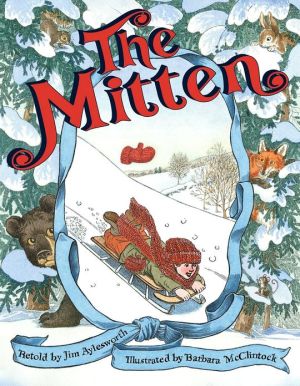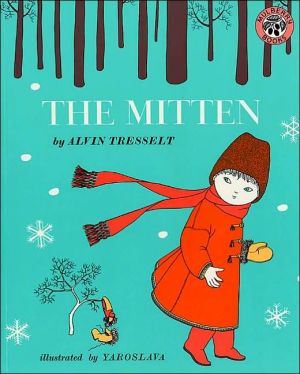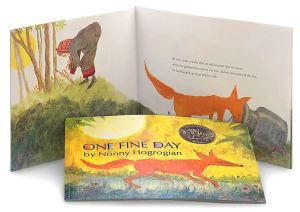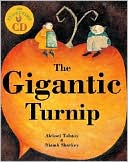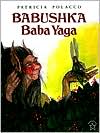The Mitten
A fresh, spirited rendition of a best-selling read-aloud classic.\ When a little boy loses a mitten in the snow, a passing squirrel finds it's the perfect place to warm his icy toes. So he sqe-e-e-e-zes inside. But he's not the only animal with that idea. How many animals can fit inside a little boy's mitten?\ Aylesworth's rollicking rhyming refrains and McClintock's delightfully expressive characters are sure to make this book everychild's storytime favorite.\ \ \ \...
Search in google:
When a little boy loses a mitten in the snow, a passing squirrel finds it's the perfect place to warm his icy toes. So he sqe-e-e-e-zes inside. But he's not the only animal with that idea. How many animals can fit inside a little boy's mitten? Aylesworth's rollicking rhyming refrains and McClintock's delightfully expressive characters are sure to make this book everychild's storytime favorite. (Sample of text) "'Br-r-r-r-r-rrrr!' said the squirrel. 'My toes are cold as ice! This mitten looks so cozy, and warm toes would feel so nice!'" Publishers WeeklyAylesworth and McClintock's (Our Abe Lincoln) retold folktale about a lost mitten opens sweetly, with a playful boy wearing the tomato-red hat, scarf and mittens his grandmother has knit for him. After a carefree sled ride, he returns home, gazing disconsolately at his mittenless hand. He gets a comforting hug and hot chocolate while, outside, a delighted squirrel crawls into the mitten. Soon a rabbit asks to share the warmth: “ 'Please!' begged the rabbit./ 'My toes are cold as ice!/ Your mitten looks so cozy,/ and warm toes would feel so nice!' ” The tale grows sillier as a fox, then a bear, repeat the rabbit's rhyme to humorous effect and persuade the mitten's occupants to let them in the tight space, massively distending the mitten (they soon discover its limits—with explosive results). McClintock adapts her 19th century–style pen-and-ink imagery to the slapstick, emphasizing the animals' gestures and facial features in a Currier & Ives winter wonderland. The lifelike animals recall Joel Chandler Harris's folktales, and the naturalism—which is an unlikely but inspired vehicle for comedy—is full of surprises. Ages 3–6. (Oct.)\\
\ Publishers WeeklyAylesworth and McClintock's (Our Abe Lincoln) retold folktale about a lost mitten opens sweetly, with a playful boy wearing the tomato-red hat, scarf and mittens his grandmother has knit for him. After a carefree sled ride, he returns home, gazing disconsolately at his mittenless hand. He gets a comforting hug and hot chocolate while, outside, a delighted squirrel crawls into the mitten. Soon a rabbit asks to share the warmth: “ 'Please!' begged the rabbit./ 'My toes are cold as ice!/ Your mitten looks so cozy,/ and warm toes would feel so nice!' ” The tale grows sillier as a fox, then a bear, repeat the rabbit's rhyme to humorous effect and persuade the mitten's occupants to let them in the tight space, massively distending the mitten (they soon discover its limits—with explosive results). McClintock adapts her 19th century–style pen-and-ink imagery to the slapstick, emphasizing the animals' gestures and facial features in a Currier & Ives winter wonderland. The lifelike animals recall Joel Chandler Harris's folktales, and the naturalism—which is an unlikely but inspired vehicle for comedy—is full of surprises. Ages 3–6. (Oct.)\\\ \ \ \ \ Children's Literature\ - Susan Treadway M.Ed\ This classic Ukrainian tale has appeared in many countries for hundreds of years. With every variation, the basic premise reappears: too many animals gather inside a container of some sort which causes it to suddenly break open. As in winter versions, keeping warm and dry is the intention of several woodland critters that would not normally be caught near one another in the same field or hedgerow. Specifically in this book, the author begins with the four seasons and a little boy who plays outside in all kinds of weather. After throwing snowballs, going sledding and making snow angels during a very cold winter day, he loses a red mitten that his grandmother knitted with a woolen hat and scarf. "Oh, no!" the boy exclaims. His grandmother assures him they will find it the next day. It was definitely time for a mug of hot cocoa to get him warm and snug again. "You've had enough of the cold for one day." Meanwhile, numerous animals happily discover the lost red mitten. Squirrel is first to make it a safe, dry haven. Next enters a rabbit, then a fox and even a bear. One by one they convince the previous tenants with the same rhyming pleas to allow them to join the growing crowd. After a rumble-tumble to get just the right fit, the animals settle down for a nap. Could a large bear really join them? "The bear squeezed and pushed, and squeezed and pushed, and sque-e-ezed and pushed- until at last . . . he got himself in." They fall asleep toasty and warm at last. Amazingly, a tiny mouse comes along and persuades the incredulous group of his great need. For just a tiny minute, things seem to be working out. . . until "the mitten BURST apart and spilled them all out onto the snow!" Hundreds ofred yarn pieces explode all over the snow-covered ground. Each one in turn declares, "What a shame!" as they walk away to locate another safe, toasty place. Of course, the next day the grandmother takes the little boy to easily find his lost red mitten. She again assures him not to worry and that she can easily knit him another one. One of the key features in this version is an important line, "And because she loved him." The classic progression of similar events usually expressed in repetitive phrases makes anticipation of what happens next much easier and predictable. Calmed fears, favorite pastimes, and a steaming mug of hot chocolate (recipe included) bring secure comfort to little ones. It is fascinating to note that the illustrator's own cozy living room appears in the book as well as being set in the Connecticut woods with stone fences from her neighborhood. In addition, the author's vast experience as a first grade teacher and children's author grounds this delightful tale for all fans of this famous read-aloud. Even though it is for very young children, older youngsters can readily enjoy one of the world's most favorite stories. Reviewer: Susan Treadway, M.Ed\ \ \ School Library JournalPreS-Gr 3—This is a delightful adaptation of the Ukrainian folktale in which a dropped mitten becomes a haven of warmth and protection for an increasing number of woodland animals until it finally bursts (or, in one story, stretches out and is carried off by the wind). From the very first sentences—"Once upon a time there was a happy little boy who loved to play. Yes, he did."—the narrative draws readers into the story and begs to be read aloud. The text contains both repetitive phrases and a memorable refrain—"'Please!' begged the fox./My toes are cold as ice!/Your mitten looks so cozy,/and warm toes would feel so nice!" The gouache and watercolor illustrations with ink outlining and detail include single pages and spreads alternating with pages that contain several small vignettes, each accompanied by a bit of text. McClintock attributes the style of her artwork to 19th-century French and British illustrators J. J. Grandville and Charles H. Bennett, and to the 1960s cartoon Top Cat. Her sweet-faced animals exhibit human personality traits in both conversation and facial expressions. Alvin Tresselt's well-loved version of the tale (HarperCollins, 1964), illustrated in black line drawings accented in five colors, and Jan Brett's popular retelling (Putnam, 1989), accompanied by paintings in her own distinctive bordered style, are both filled with patterns and details in clothing and settings that characterize the tale's ethnic origin. Aylesworth's tale belongs in every collection, as well.—Susan Scheps, Shaker Heights Public Library, OH\ \ \ \ \ Kirkus ReviewsA little boy goes out to play in the snow with the mittens his grandmother knitted him, but comes back with only one. They'll look for it later, she says, and comforts him with hot cocoa. Meanwhile a squirrel discovers the mitten and curls up in it for a warm nap. Then a rabbit, a fox and a bear each come along, and after much pleading they are let in. Finally, a tiny mouse manages to talk his way in, with a mitten-destroying result. Aylesworth brings a folksy voice to the story, and McClintock's detailed black-lined illustrations set on snowy white backgrouds add to the vintage sensibility. She invests her animals with enormous personality and the scene with an absurd humor with the use of sequential vignettes, making it both visually and tonally quite different from Jan Brett's 1992 version. What really shines is the temptation offered to little imaginations: What happens to all those lost mittens when you're not there? Certainly fun to think about while drinking hot cocoa on a snowy day-recipe included. Fresh. (Picture book. 3-6)\ \
